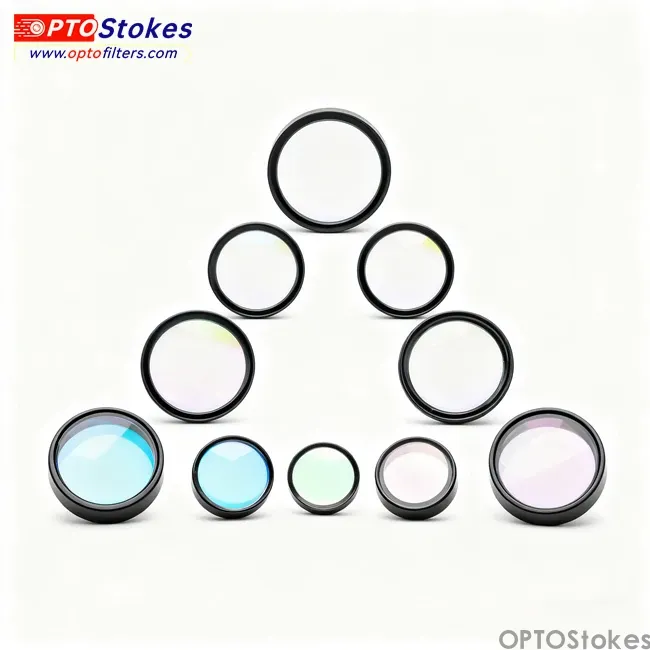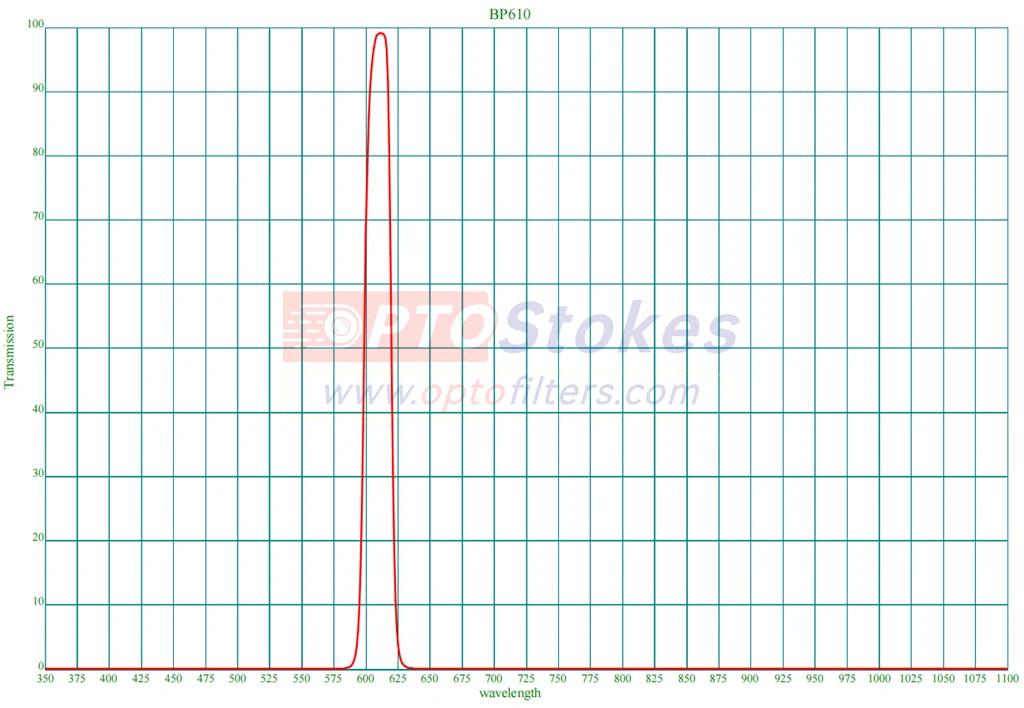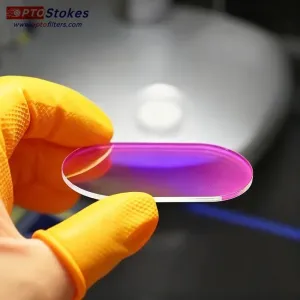BP610nm Bandpass Filter | FWHM 20nm, Thickness 1.1mm
The BP610-20nm-1.1mm bandpass filter is precision-engineered to deliver optimal performance for red fluorophore detection, balancing spectral selectivity with excellent light collection efficiency. This versatile bandpass filter features a 20nm full width at half maximum (FWHM) centered at 610nm with transmission greater than 90% across the 605-615nm passband, providing ideal performance for mCherry, Texas Red, and other orange-red emitting fluorophores. With comprehensive blocking from 350-1100nm at transmission less than 1%, this filter ensures clean signal isolation in multi-channel fluorescence systems. The optimized 1.1mm substrate thickness provides an excellent balance between compact integration and mechanical stability, making it suitable for diverse microscopy and flow cytometry applications. Manufactured by OPTOStokes using advanced high precision coating technology, this filter delivers consistent performance for demanding research and clinical applications.
Technical Specifications
| Parameter | Specification |
|---|---|
| Center Wavelength (CWL) | 610nm ± 3nm at T greater than 90% |
| Transmission Range | 605-615nm at T greater than 90% |
| Full Width at Half Maximum (FWHM) | 20nm ± 3nm |
| Blocking Range | 350-1100nm at T less than 1% |
| Optical Density (OD) | Greater than 2.0 (equivalent to T less than 1%) |
| Substrate Thickness | 1.1mm |
| Surface Quality | 60/40 scratch-dig per MIL-PRF-13830B |
| Coating Type | Hard ion-assisted deposition |
| Part Number | 20219982 |
Key Performance Features
This red filter achieves exceptional spectral performance through its optimized 20nm bandwidth design. The FWHM provides an ideal balance between wavelength selectivity and light collection efficiency, making it suitable for applications where both spectral purity and signal strength are important. Peak transmission exceeding 90% across the 605-615nm range ensures maximum photon throughput while maintaining adequate separation from yellow-green channels at 560-590nm and far-red channels at 650-680nm.
The precisely controlled passband efficiently captures emissions from mCherry (emission maximum at 610nm), Texas Red (615nm peak), and tdTomato (581nm peak with significant emission extending to 610nm). This spectral positioning makes the filter particularly effective for multi-color imaging applications where moderate spectral resolution is required without sacrificing signal levels. The 20nm bandwidth collects sufficient fluorophore emission to maximize signal-to-noise ratios while preventing excessive spectral overlap with adjacent channels.
Comprehensive blocking performance with transmission below 1% (optical density greater than 2) from 350-1100nm effectively suppresses green and yellow channel crosstalk, blocks excitation light from typical 561nm and 594nm laser sources, and eliminates far-red and near-infrared interference. This deep rejection ensures clean fluorescence detection in multi-channel imaging systems and prevents detector saturation from intense excitation sources.
The optimized 1.1mm substrate thickness represents a balanced engineering choice, providing superior rigidity compared to ultra-thin 1.0mm substrates while maintaining more compact dimensions than standard 2.0mm alternatives. This intermediate thickness facilitates integration into space-constrained filter wheels and motorized changers while ensuring adequate mechanical stability for secure mounting. The improved thermal mass compared to thinner substrates enhances temperature stability during extended imaging sessions.
Applications
The BP610-20nm-1.1mm filter excels across diverse applications demanding balanced performance between spectral precision and signal collection:
Multi-Color Fluorescence Microscopy: Widefield and confocal microscopy systems utilizing 3-5 fluorescence channels benefit from the BP610 filter's balanced spectral characteristics. The filter enables clean detection of mCherry, tdTomato, and Texas Red while maintaining adequate separation from GFP/YFP channels at 510-560nm and Cy5/Alexa Fluor 647 channels at 665-680nm. Cell biology research applications including protein localization, cellular co-localization studies, and tissue immunofluorescence rely on this versatile performance.
Flow Cytometry: Multi-parameter flow cytometry panels employing PE-Texas Red, PE-Cy5, and similar tandem conjugates require filters that balance spectral resolution with light collection efficiency. The 20nm bandwidth provides adequate channel separation while collecting sufficient fluorescence for sensitive detection at high cell velocities. Clinical








